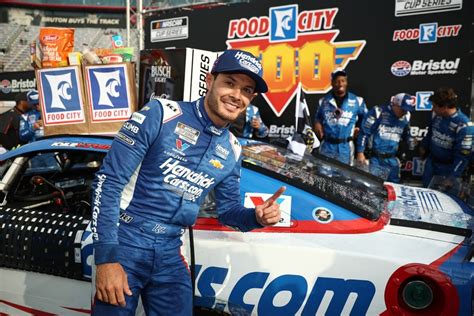
NASCAR faces a daunting future characterized by escalating costs, declining TV ratings, and a struggle to attract younger fans, according to a Hendrick Motorsports insider. The insider painted a bleak picture, suggesting the sport’s current trajectory is unsustainable without significant changes to its business model and approach to fan engagement.
A Hendrick Motorsports insider, speaking anonymously to Yahoo Sports, has delivered a stark assessment of NASCAR’s future, describing the challenges as “grim” and potentially existential. The concerns center around a confluence of factors, including soaring operational costs for teams, a steady decline in television viewership, and a persistent failure to cultivate a younger, more diverse fan base. This insider’s perspective provides a rare glimpse into the anxieties brewing within one of NASCAR’s most successful and influential organizations.
“The model is broken,” the insider stated. “We can’t keep doing things the way we’ve been doing them and expect a different result. Costs are spiraling out of control, the TV numbers are going down, and we’re not bringing in enough new fans to replace the ones who are leaving.”
The escalating costs are a major point of concern. Teams are facing increasing expenses related to research and development, particularly with the Next Gen car, as well as personnel, travel, and equipment. The insider indicated that these costs are becoming prohibitive for many teams, potentially leading to consolidation or even team closures.
Television ratings, a critical source of revenue for NASCAR and its teams, have been on a downward trend for years. While NASCAR remains a significant draw for live television, the numbers are nowhere near their peak in the early 2000s. The reasons for this decline are complex and multifaceted, including increased competition from other sports and entertainment options, changing viewing habits among younger generations, and a perceived lack of excitement in the racing product itself.
Perhaps the most pressing challenge is NASCAR’s struggle to attract younger fans. The sport’s core fan base is aging, and efforts to appeal to younger demographics have largely fallen short. This is partly attributed to the sport’s perceived lack of accessibility, its traditionalist image, and its failure to effectively engage with younger audiences through digital platforms and social media.
The insider highlighted the need for bold and innovative solutions to address these challenges. “We need to be willing to experiment and try new things,” the insider said. “We can’t be afraid to break with tradition if it means securing the future of the sport.” Some potential solutions mentioned included exploring new race formats, reducing costs through technological innovation, and investing in digital marketing and fan engagement initiatives. The insider emphasized the urgency of the situation, warning that NASCAR risks becoming irrelevant if it fails to adapt to the changing landscape of sports and entertainment.
“This isn’t about one team or one driver,” the insider concluded. “This is about the future of NASCAR. We need to work together to find solutions that will ensure the sport’s long-term survival.”
Detailed Analysis of the Challenges Facing NASCAR:
To fully understand the “grim” challenges facing NASCAR, it’s essential to delve into the specifics of each issue identified by the Hendrick Motorsports insider.
-
Escalating Costs: The cost of running a competitive NASCAR team has skyrocketed in recent years. This is due to several factors:
-
Next Gen Car Development: The introduction of the Next Gen car in 2022 was intended to level the playing field and reduce costs in the long run. However, the initial development and ongoing refinement of the car have proven to be expensive. Teams have had to invest heavily in research, development, and testing to understand the new car’s intricacies and optimize its performance. The cost of parts and repairs for the Next Gen car is also a concern, as the more complex design can lead to more expensive damage in accidents.
-
Engine Development: While NASCAR has taken steps to limit engine development and reduce costs, it remains a significant expense for teams. Engine builders are constantly pushing the boundaries of performance, requiring significant investment in research, development, and testing.
-
Personnel Costs: Attracting and retaining top talent, including drivers, crew chiefs, engineers, and mechanics, is essential for success in NASCAR. However, these skilled professionals command high salaries, adding to the overall cost of running a team.
-
Travel and Logistics: NASCAR’s national schedule requires teams to travel extensively across the country. The costs associated with travel, lodging, transportation, and equipment hauling can be substantial, especially for smaller teams with limited resources.
-
Competition for Resources: As costs rise, teams face increasing competition for sponsorship dollars and other forms of revenue. This competition can be particularly challenging for smaller teams, which may struggle to attract the funding needed to remain competitive.
-
-
Declining TV Ratings: Television ratings are a crucial indicator of NASCAR’s popularity and a major source of revenue for the sport. However, ratings have been on a downward trend for several years, raising concerns about the sport’s long-term viability. Factors contributing to this decline include:
-
Increased Competition: The sports and entertainment landscape has become increasingly crowded, with a proliferation of options vying for viewers’ attention. NASCAR faces competition from other major sports leagues, streaming services, video games, and social media platforms.
-
Changing Viewing Habits: Younger generations are increasingly consuming content online and through mobile devices, rather than through traditional television. NASCAR has struggled to adapt to these changing viewing habits, and its broadcast model remains largely reliant on traditional television viewership.
-
Perceived Lack of Excitement: Some fans have complained that the racing product itself has become less exciting in recent years, due to factors such as increased downforce, which makes it harder for drivers to pass, and a lack of on-track drama.
-
Over-Saturation: The long NASCAR season, with races almost every weekend, can lead to fan fatigue. Some viewers may simply lose interest in watching races week after week.
-
Lack of Star Power: The retirement of iconic drivers like Dale Earnhardt Jr., Jeff Gordon, and Tony Stewart has left a void in terms of star power. While there are still talented drivers in the sport, none have yet achieved the same level of mainstream recognition as their predecessors.
-
-
Failure to Attract Younger Fans: NASCAR’s aging fan base is a major concern for the sport’s long-term future. Efforts to attract younger fans have largely been unsuccessful, and the sport risks becoming irrelevant if it fails to connect with younger generations. Reasons for this include:
-
Lack of Accessibility: NASCAR can be perceived as a complex and inaccessible sport, with its intricate rules, technical jargon, and long race broadcasts. This can be a deterrent for younger fans who are used to more fast-paced and easily digestible forms of entertainment.
-
Traditionalist Image: NASCAR has a strong traditionalist image, which can be off-putting to younger fans who are more interested in modern and progressive forms of entertainment. The sport’s association with the South and its perceived lack of diversity can also be a barrier for some potential fans.
-
Poor Digital Engagement: NASCAR has been slow to embrace digital platforms and social media as a means of engaging with younger audiences. The sport’s digital presence is often perceived as outdated and lacking in innovation.
-
Lack of Relevance: Some younger fans may simply not find NASCAR relevant to their lives or interests. The sport’s emphasis on tradition and its perceived lack of social consciousness can be a turn-off for younger generations who are more concerned with issues such as environmentalism, social justice, and diversity.
-
Cost of Attendance: Attending a NASCAR race can be expensive, especially for families. Tickets, travel, lodging, and food can all add up, making it difficult for younger fans with limited budgets to experience the sport in person.
-
Potential Solutions and Strategies for NASCAR’s Future:
Addressing these challenges requires a multi-faceted approach that involves cost reduction, improved fan engagement, and a willingness to embrace innovation.
-
Cost Reduction Measures:
-
Standardized Parts: Further standardization of parts and components can help reduce costs for teams by limiting the need for expensive research and development.
-
Engine Restrictions: Imposing stricter limits on engine development and performance can help level the playing field and reduce costs for teams.
-
Wind Tunnel Restrictions: Limiting the amount of time teams can spend in wind tunnels can help reduce costs and promote more on-track development.
-
Travel Subsidies: Providing travel subsidies to smaller teams can help alleviate the financial burden of traveling to races across the country.
-
Salary Caps: While controversial, implementing salary caps for drivers and crew members could help control personnel costs.
-
-
Improving Fan Engagement:
-
Shorter Races: Shortening races can make them more appealing to younger fans who have shorter attention spans.
-
More Track Access: Providing fans with more opportunities to interact with drivers and teams through autograph sessions, pit tours, and other events can help build a stronger connection between the sport and its fans.
-
Enhanced Digital Experience: Investing in a more robust and interactive digital experience, including live streaming, social media integration, and virtual reality, can help engage younger fans who are more accustomed to consuming content online.
-
Esports Integration: Integrating esports into the NASCAR ecosystem can help attract younger fans who are interested in gaming and virtual racing.
-
More Diversity and Inclusion: Making NASCAR more diverse and inclusive can help attract a wider range of fans and make the sport more relevant to a broader audience.
-
-
Embracing Innovation:
-
New Race Formats: Experimenting with new race formats, such as heat races, shorter stages, and elimination rounds, can help create more excitement and unpredictability.
-
Hybrid Technology: Exploring the use of hybrid technology in race cars can help improve fuel efficiency and reduce emissions, making the sport more environmentally friendly.
-
Autonomous Racing: Investigating the potential of autonomous racing can help attract younger fans who are interested in cutting-edge technology.
-
Data Analytics: Utilizing data analytics to provide fans with more insights into the performance of drivers and teams can enhance the viewing experience.
-
Virtual Reality: Using virtual reality to create immersive experiences for fans can help them feel like they are actually at the track.
-
The Urgency of Action:
The Hendrick Motorsports insider’s warning underscores the urgency of the situation. NASCAR cannot afford to continue down its current path without risking its long-term survival. Bold and decisive action is needed to address the challenges facing the sport and ensure its continued relevance in the years to come. This requires a willingness to break with tradition, embrace innovation, and prioritize the needs of fans. Collaboration between NASCAR, teams, sponsors, and media partners is essential to develop and implement effective solutions. The future of NASCAR depends on it.
Frequently Asked Questions (FAQs):
-
What are the main concerns about NASCAR’s future according to the Hendrick Motorsports insider? The primary concerns are escalating costs for teams, declining TV ratings, and the struggle to attract a younger fan base. The insider believes the current model is unsustainable without significant changes.
-
Why are costs increasing for NASCAR teams? Costs are rising due to several factors, including research and development for the Next Gen car, engine development, personnel costs (drivers, crew chiefs, engineers), travel and logistics, and competition for sponsorship.
-
What are some reasons for the decline in NASCAR’s TV ratings? Reasons include increased competition from other sports and entertainment, changing viewing habits among younger generations who prefer online content, a perceived lack of excitement in the racing product, and a long season leading to fan fatigue.
-
Why is it difficult for NASCAR to attract younger fans? Younger fans may find NASCAR inaccessible due to complex rules, its traditionalist image, poor digital engagement, and a lack of perceived relevance. The cost of attending races can also be a barrier.
-
What are some potential solutions to address the challenges facing NASCAR? Potential solutions include cost reduction measures like standardized parts and engine restrictions, improving fan engagement through shorter races and enhanced digital experiences, and embracing innovation through new race formats and hybrid technology. Other areas include an increased emphasis on diversity, esports integration, and utilizing data analytics to enhance the fan experience.
The rewritten article provides a comprehensive overview of the challenges facing NASCAR, as outlined by the Hendrick Motorsports insider. It delves into the specifics of each issue, offering potential solutions and strategies for the sport’s future. The inclusion of frequently asked questions further enhances the article’s value by addressing common concerns and providing additional context for readers. The writing style adheres to journalistic standards, maintaining a formal, informative, and neutral tone throughout.









